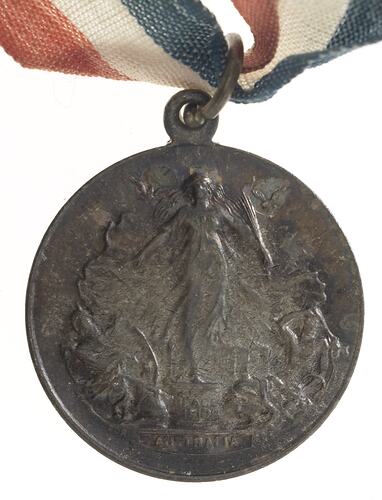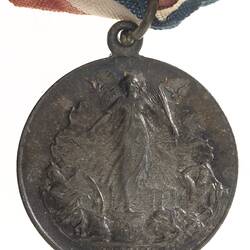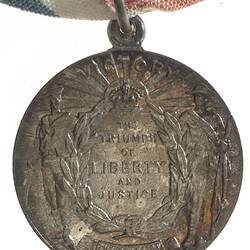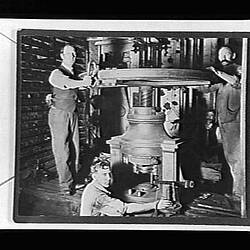Summary
Medal awarded to school children of the Commonwealth of Australia in 1919.
Of the commemorative medals issued to mark the end of the First World War, the most common was the so-called 'Peace' or 'Victory' medal issued to every child in Australia aged 0-14 years (and aged up to 16 if parents were in the armed forces). The medal was designed by Charles Douglas Richardson, better known for his work as a sculptor. Time constraints as well as pressure from the production of other victory medals meant that no single manufacturer could make the 1,670,000 medals. Six were therefore selected: Amor, Stokes, Schlank, Parkes, Angus & Coote (who later withdrew) and Platers. The medals were silvered bronze, with silver issues for special presentations. The Defence Department supplied a red, white and blue striped ribbon and pin. Distribution began in March 1919. Victorian school children received their medals on Friday 18 July and on 'Peace Day' on Saturday 19 July.
Mint: Stokes & Sons.
Obverse Description
Peace with two flying doves on pedestal inscribed, PEACE / 1919 below AUSTRALIA; figure in chains on left and another entangled in bush to right
Reverse Description
Australian sailor and soldier support wreath; above, VICTORY; within, THE / TRIUMPH / OF / LIBERTY / AND / JUSTICE; below on plaque, THE PEACE OF 1919
Edge Description
Plain
Significance
Of the commemorative medals issued to mark the end of the First World War, the most common was the so-called 'Peace' or 'Victory' medal issued to every child in Australia aged 0-14 years (and aged up to 16 if parents were in the armed forces). The medal was suggested in Federal Parliament by Liberal-National Party member Edward Corser just three days after the Armistice was signed. The medal was approved and the Defence Department was made responsible for its production and distribution.The medals were distributed by a Peace Celebrations Committee in each state.
The medal was designed by Charles Douglas Richardson, better known for his work as a sculptor (refer Parties module). The original obverse design submitted by Richardson, a Liberty bust, was rejected on the basis that its relief was too high, but it is not known why its relief was not reduced rather than a completely new design substituted, that of the full-length female figure of Peace.
Time constraints as well as pressure from the production of other victory medals meant that no single manufacturer could make the 1,670,000 medals. Six were therefore selected: Amor, Stokes, Schlank, Parkes, Angus & Coote (who later withdrew) and Platers. Amor and Stokes made the largest number. The medals were silvered bronze, with silver issues for special presentations. The Defence Department supplied the red, white and blue striped ribbon and pin.
Distribution began in March 1919. Victorian school children received their medals on Friday 18 July and on 'Peace Day' on Saturday 19 July. -Carlisle, Leslie J. & Fleig, Peter. 2002. The Great War Children's Peace Medal. NMAA Journal. 13: 48-72. -D.Tout-Smith 15/9/2003.
More Information
-
Collecting Areas
-
Acquisition Information
Transfer from National Gallery of Victoria (NGV), 15 Mar 1976
-
Date Issued
1919 AD
-
Issued By
-
Mint
-
Artist
Douglas Richardson, 1919
This is may be Charles Douglas Richardson - it is executed in his style - but Carlisle says Douglas Richardson. -D. Tout-Smith 5/2/3004. -
Series
-
Material
Silvered Bronze
-
Axis
12
-
Classification
-
Category
-
Discipline
-
Type of item
-
Dimensions
70 mm (Height), 27 mm (Outside Diameter), 9.36 g (Weight)
Height includes extended ribbon
-
Shape
Round and ribbon
-
References
Car.1919/2
[Article] Carlisle, Leslie J. & Fleig, Peter. 2002. The Great War Children's Peace Medal. Journal of the Numismatic Association of Australia. 13: 48-72.
[Book] Carlisle, Leslie J. 1983. Australian commemorative medals and medalets from 1788.
-
Keywords



